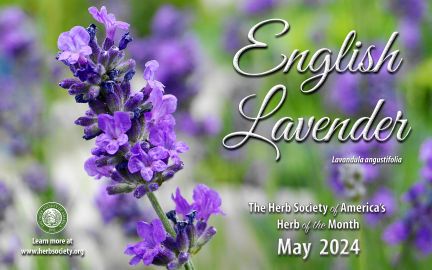|
Program Info
April Meeting: "The Beauty of Wildflowers" Presentation and Herbal Shoppe
When: Wednesday, April 17, 2024
10 am - 12:30 pm
Where: Wimberley Presbyterian Church
956 FM2325, Wimberley, TX 78676
RSVP to Lisa Valentine at valentine_lisa@msn.com
2023-2024 Calendar of Events |
|
Herb of the Month - May 2024
(Click on the image below for recipes)
Lavender (Lavandula angustifolia)
 Lavandula angustifolia is known as English lavender, true lavender, fine lavender and common lavender. It is generally hardy between zones 5 to 9. Lavandula angustifolia is known as English lavender, true lavender, fine lavender and common lavender. It is generally hardy between zones 5 to 9.
 Lavindin, L. x intermedia is a cross between common lavender and spike lavender L. latifolia. 'Grosso' is a variety which, among others, produces much of the world's lavender essential oil. This oil is used in products such as soaps and lotions. 'Provence' is another variety of L. x intermedia that can be used for cooking as well as soaps and lotions. These varieties are not generally used in aromatherapy or the perfume industry. Lavindin, L. x intermedia is a cross between common lavender and spike lavender L. latifolia. 'Grosso' is a variety which, among others, produces much of the world's lavender essential oil. This oil is used in products such as soaps and lotions. 'Provence' is another variety of L. x intermedia that can be used for cooking as well as soaps and lotions. These varieties are not generally used in aromatherapy or the perfume industry.
 Lavender prefers to grow in full sun of 6 or more hours per day and benefits from afternoon shade in hot climates. It will tolerate partial shade but it will produce fewer flowers and leggy growth. Lavender prefers to grow in full sun of 6 or more hours per day and benefits from afternoon shade in hot climates. It will tolerate partial shade but it will produce fewer flowers and leggy growth.
 Grow lavender in well-drained soil which can be amended with gravel or sand, and be kept on the dry side once established. It will grow well in the ground, raised beds and in containers with minimal fertilizer. Ideal growing conditions include low humidity and good air circulation. Grow lavender in well-drained soil which can be amended with gravel or sand, and be kept on the dry side once established. It will grow well in the ground, raised beds and in containers with minimal fertilizer. Ideal growing conditions include low humidity and good air circulation.
 L. angustifolia flowers are quite often the preferred lavender for use in teas, cookies and other confections as well as savory dishes. Lavender is a component of "Herbes de Provence" and Lady Grey Tea. L. angustifolia flowers are quite often the preferred lavender for use in teas, cookies and other confections as well as savory dishes. Lavender is a component of "Herbes de Provence" and Lady Grey Tea.
 Some varieties of lavender used for culinary purposes include: 'Provence' (L. x intermedia) for meats and savory dishes, and 'Royal Velvet', 'Betty's Blue' and 'Melissa' which are all L. angustifolia. Taste a lavender bud for flavor to determine suitability for culinary uses. Some varieties of lavender used for culinary purposes include: 'Provence' (L. x intermedia) for meats and savory dishes, and 'Royal Velvet', 'Betty's Blue' and 'Melissa' which are all L. angustifolia. Taste a lavender bud for flavor to determine suitability for culinary uses.
 According to The Lavender Association, there are over 45 species of lavender, with more yet to be classified, and more than 450 varieties. According to The Lavender Association, there are over 45 species of lavender, with more yet to be classified, and more than 450 varieties.
 Since Roman times, lavender has been used for healing, washing, repelling insects and for its antiseptic qualities. Since Roman times, lavender has been used for healing, washing, repelling insects and for its antiseptic qualities.
 Lavender was considered effective against infection in the sixteenth and seventeenth centuries when the plague and cholera ran rampant. Lavender was considered effective against infection in the sixteenth and seventeenth centuries when the plague and cholera ran rampant.
 Roman soldiers took lavender with them to dress war wounds as well as the other healing properties known at the time. These included treating upset stomachs, kidney disorders, dropsy, jaundice and easing insect bites. Roman soldiers took lavender with them to dress war wounds as well as the other healing properties known at the time. These included treating upset stomachs, kidney disorders, dropsy, jaundice and easing insect bites.
 Lavender was used to treat head lice in the twelfth century and up to 1874 in France. Lavender was used to treat head lice in the twelfth century and up to 1874 in France.
 During World War I, lavender oil and sphagnum moss were used together to dress war wounds since antiseptics were in short supply at the time. During World War I, lavender oil and sphagnum moss were used together to dress war wounds since antiseptics were in short supply at the time.
 Historically lavender has been used to treat depression, insomnia, anxiety and fatigue. Current research supports the calming, soothing and sedative effects of lavender when inhaled. Historically lavender has been used to treat depression, insomnia, anxiety and fatigue. Current research supports the calming, soothing and sedative effects of lavender when inhaled.
 While both the foliage and flowers are fragrant, typically flower buds are harvested and dried to scent potpourri, sleep pillows and other projects. While both the foliage and flowers are fragrant, typically flower buds are harvested and dried to scent potpourri, sleep pillows and other projects.
|

